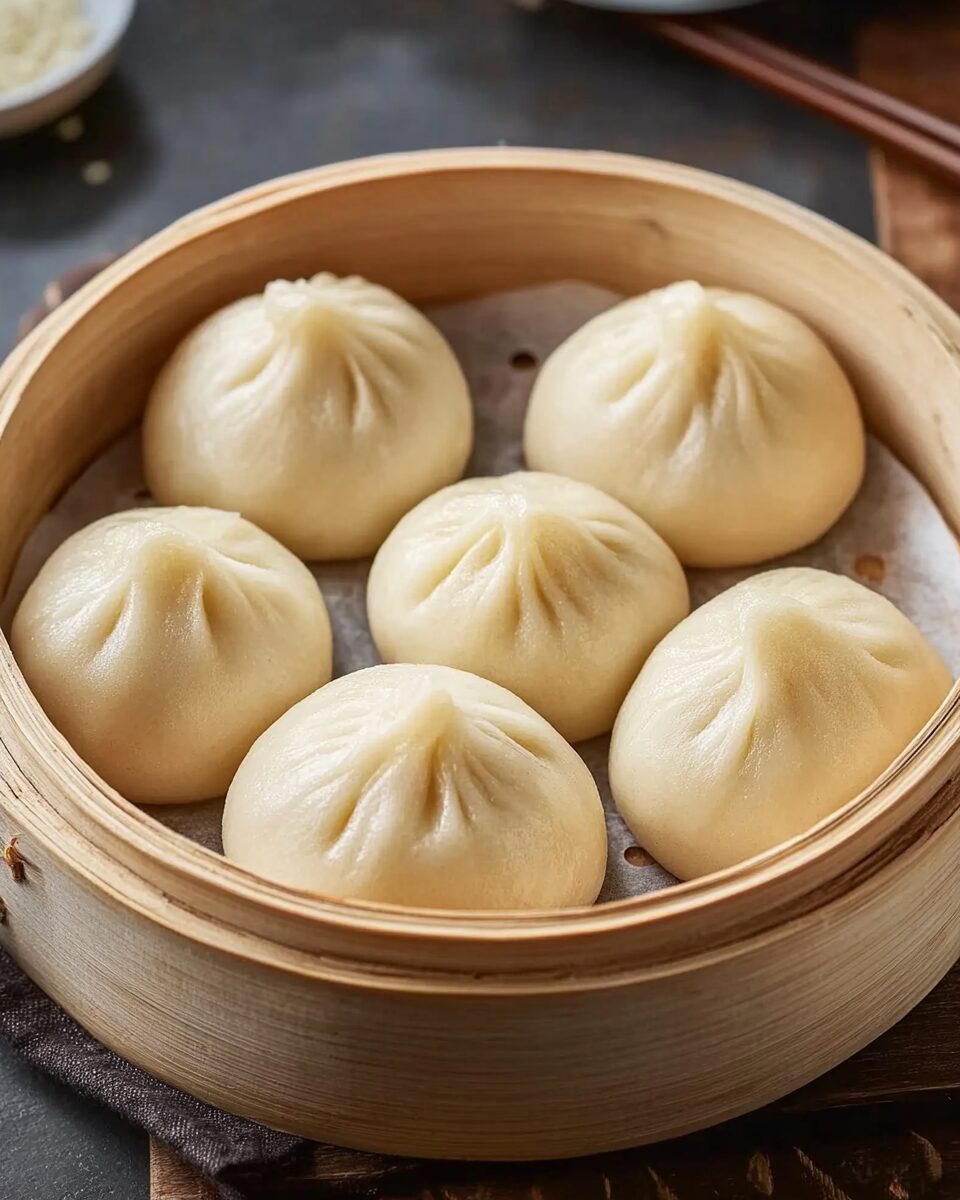Chinese Steamed Buns, also known as Baozi, are a delicious and traditional Chinese dish filled with savory fillings like pork, vegetables, or chicken, wrapped in a soft, fluffy dough. They are steamed to perfection, making them a popular snack or appetizer in Chinese cuisine.
Full Recipes:
Ingredients
- 2 cups all-purpose flour
- 2 teaspoons baking powder
- 2 teaspoons sugar
- 3/4 cup warm water
- 1 tablespoon vegetable oil
- 1 teaspoon active dry yeast
- Filling of your choice (pork, chicken, vegetables, etc.)
Directions
- In a small bowl, mix warm water and yeast. Let it sit for 5-10 minutes until it becomes frothy.
- In a separate large bowl, combine flour, baking powder, and sugar.
- Add the yeast mixture and vegetable oil to the dry ingredients. Mix together until a dough forms.
- Knead the dough for about 5 minutes until smooth.
- Cover the dough with a damp cloth and let it rise for about 1 hour or until doubled in size.
- Punch down the dough and divide it into small portions.
- Roll each portion into a small circle and fill with your desired filling.
- Fold the dough over the filling and pinch the edges to seal.
- Steam the buns in a steamer for 12-15 minutes, or until fluffy and cooked through.
- Serve hot and enjoy!
Nutrients
- Serving Size: 1 bun
- Calories: 220 kcal
- Protein: 5g
- Carbohydrates: 45g
- Fat: 4g
- Fiber: 2g
- Sodium: 160mg
Historical Significance
The origins of baozi date back over a millennium, with historical records suggesting their creation during the Three Kingdoms period (220–280 CE). A popular legend attributes their invention to Zhuge Liang, a chancellor of the Shu Han state, who crafted these buns to appease river deities during a military campaign. The story goes that Zhuge Liang, tasked with crossing a river, ordered the creation of steamed buns shaped like human heads to serve as offerings to the river god, preventing a storm from sinking his ships. While this tale may be apocryphal, it adds a layer of cultural intrigue to the history of baozi.
Over the centuries, baozi has evolved significantly, with various regions in China developing their unique versions. The most famous regional variations include the soup-filled tangbao from Kaifeng, the delicate xiaolongbao from Shanghai, and the savory, pork-filled baozi that is common in many parts of China. Each type has its specific method of preparation and unique ingredients, but they all share the same fundamental characteristic: a soft, steamed dough.
As China opened up to international trade and migration, baozi began to spread globally, finding its place in Asian communities in the United States, Europe, and beyond. Today, Chinese steamed buns are enjoyed by people of all backgrounds and are found in various forms, including dim sum offerings and casual street food.
Culinary Variations
Chinese steamed buns are celebrated for their diversity, both in shape and filling. While the classic baozi features a soft, leavened wheat flour dough filled with ingredients like minced pork, beef, or vegetables, regional specialties offer unique twists that give each variety its distinct flavor and texture.
For instance, the xiaolongbao, originating from the Jiangnan region, is renowned for its thin skin and the burst of flavorful broth that accompanies each bite. Xiaolongbao, unlike typical baozi, contains a gelatinized meat broth inside, which turns into a savory soup once the bun is steamed. This soup-filled bun has become popular in many countries and is often seen as a more refined, delicate variant of the standard steamed bun.
In the city of Kaifeng, tangbao, another variation, is characterized by its large size and a generous portion of broth inside. The tangbao requires a unique preparation method that includes making the broth from meat, which is then cooled and solidified. When the buns are steamed, the broth inside liquefies, creating a juicy, flavorful center.
In Hong Kong, the ping on bun is a sweet variation filled with lotus seed paste and stamped with symbols of peace. These sweet baozi are traditionally consumed during the Cheung Chau Bun Festival, a vibrant annual celebration held in Hong Kong. The festival features towering structures made entirely of buns, and it serves as a symbol of cultural preservation and celebration. While sweet baozi like the ping on bun are more of a rarity compared to their savory counterparts, they offer a delightful contrast and add to the diversity of this beloved dish.
Even within the savory baozi category, there are numerous variations in terms of fillings. Traditional fillings include pork, beef, chicken, and lamb, but more contemporary versions incorporate ingredients such as tofu, mushrooms, and other vegetables. For example, vegetarian baozi might be filled with a mixture of mushrooms, bok choy, cabbage, and seasonings. This flexibility in filling allows steamed buns to be adapted to various dietary preferences and regional tastes.
Preparation Techniques
The art of making Chinese steamed buns involves several meticulous steps, from preparing the dough to crafting the perfect filling. Steamed buns are usually made with a simple dough consisting of wheat flour, water, yeast, and a pinch of sugar. The dough is leavened by the yeast, which causes it to rise and become light and airy.
First, the dough ingredients are mixed together, and the dough is kneaded until it becomes smooth and elastic. The kneading process is essential for developing the right texture, and it helps the dough to rise evenly when steamed. After kneading, the dough is covered and left to rise for about an hour or until it has doubled in size. This resting period allows the yeast to activate, giving the dough its signature fluffy texture.
Once the dough has risen, it is punched down to release the air and then divided into small portions. Each portion is rolled into a ball and flattened into a small disc. The flattened dough is then filled with a savory filling, such as minced pork, vegetables, or a combination of both. The filling is spooned into the center of the dough, and the edges are gathered and pinched together to form a bun. This folding technique is crucial for ensuring that the buns hold their shape during steaming and that the filling stays inside.
Steaming the buns requires a gentle, consistent heat to ensure the dough becomes soft and fluffy without overcooking or undercooking. The buns are typically placed in a bamboo steamer lined with parchment paper to prevent sticking. Steaming times vary depending on the size of the buns, but typically, they take around 10-15 minutes to cook fully. Once steamed, the buns should be light, fluffy, and cooked through, with the filling steaming perfectly inside.
For some regional variations, like xiaolongbao, the broth-filled buns are carefully sealed and steamed so that the gelatinized broth inside turns into a savory soup. This particular variant requires additional care during preparation to prevent the broth from leaking out.
Cultural Significance
Beyond their culinary appeal, steamed buns hold a special place in Chinese culture. Baozi is often associated with festivals, family gatherings, and expressions of goodwill. For example, during the Lunar New Year, it is customary to prepare and consume baozi as a symbol of prosperity and unity. The round shape of the buns is thought to represent completeness, and eating them is believed to bring good fortune and success in the coming year. In regions like Cheung Chau in Hong Kong, the annual Bun Festival features towering structures made entirely of buns, attracting visitors from around the world. The festival has historical roots in a local legend, where villagers would prepare buns as an offering to the deities to ward off evil spirits.






